A Multi-Method Analysis of a Color Painting on Ancient Architecture from Anyuan Temple in Chengde, China
Abstract
:1. Introduction
2. Materials and Methods
2.1. Materials
2.2. Methods
2.2.1. Energy Dispersive Spectrometry (EDS)
2.2.2. Micro Raman Spectroscopy (m-RS)
2.2.3. X-ray Diffraction Meter
2.2.4. Pyrolysis–Gas Chromatography–Mass Spectrometry (Py-GC/MS)
3. Results and Discussion
3.1. Analysis of Pigments
3.1.1. White Pigment Analysis
3.1.2. Red Pigment Analysis
3.1.3. Green Pigment Analysis
3.1.4. Blue Pigment Analysis
3.2. Analysis of Binder
4. Conclusions
Author Contributions
Funding
Institutional Review Board Statement
Informed Consent Statement
Data Availability Statement
Conflicts of Interest
References
- Fu, P.; Teri, G.; Li, J.X.; Huo, Y.; Li, Y. Analysis of an Ancient Architectural Painting from the Jiangxue Palace in the Imperial Museum, Beijing, China. Anal. Lett. 2021, 54, 684–697. [Google Scholar] [CrossRef]
- Peifan, Q.; Deqi, Y.; Qi, M.; Aijun, S.; Jianwei, H. Study and Restoration of the Yi Ma Wu Hui Layer of the Ancient Coating on the Putuo Zongcheng Temple. Int. J. Archit. Herit. 2020, 151, 1707–1721. [Google Scholar] [CrossRef]
- Han, K.; Yang, H.; Teri, G.; Hu, S.; Li, J. Spectroscopic Investigation of a Color Painting on an Ancient Wooden Architecture from the Taiping Heavenly Kingdom Prince Dai’s Mansion in Jiangsu, China. Minerals 2023, 13, 224. [Google Scholar] [CrossRef]
- Teri, G.; Han, K.; Huang, D.; Li, Y.; Tian, Y. A Study on the Materials Used in the Ancient Architectural Paintings from the Qing Dynasty Tibetan Buddhist Monastery of Puren, China. Materials 2023, 16, 6404. [Google Scholar] [CrossRef] [PubMed]
- Zhou, W. Analysis and Research on the Production Technology of Oil Decoration and Color Painting of Ancient Buildings and the Materials of Floor Ornaments; Northwest University: Xi’an, China, 2009. [Google Scholar]
- Zhang, Y. Study on the Synergistic Mechanism of Various Materials in the Oil Filling Curing Process of Ancient Painted Floor Pillars; Shaanxi Normal University: Xi’an, China, 2020. [Google Scholar]
- Yang, H. Research on materials and techniques of conservation and restoration of ancient architectural color paintings. Study Nat. Cult. Herit. 2022, 7, 3–18. [Google Scholar]
- Lei, Z.; Wu, W.; Shang, G.; Wu, Y.; Wang, J. Study on Colored Pattern Pigments of a Royal Taoist Temple beside the Forbidden City (Beijing, China). Vib. Spectrosc. 2017, 92, 234–244. [Google Scholar] [CrossRef]
- Gard, F.S.; Santos, D.M.; Daizo, M.B.; Mijares, J.L.; Halac, E.B. A noninvasive complementary study of an Egyptian polychrome cartonnage pigments using SEM, EPMA, and Raman spectroscopy. Surf. Interface Anal. 2020, 52, 755–769. [Google Scholar] [CrossRef]
- Souto, J.; Prieto, A.C.; Gutiérrez-Vicente, V. Raman analysis of Gothic wall paintings in the apse of the Santiago Apóstol church in Alcazarén. J. Cult. Herit. 2016, 22, 1061–1065. [Google Scholar] [CrossRef]
- Zou, W.; Yeo, Y. Investigation on the Painting Materials and Profile Structures Used in Ancient Chinese Folk Architectural Paintings by Multiple Analytical Methods. Coatings 2022, 12, 320. [Google Scholar] [CrossRef]
- Shen, A.G.; Wang, X.H.; Xie, W.; Shen, J.; Hu, J.M. Pigment identification of colored drawings from Wuying Hall of the Imperial Palace by micro-Raman spectroscopy and energy dispersive X-ray spectroscopy. J. Raman Spectrosc. 2010, 37, 230–234. [Google Scholar] [CrossRef]
- Liu, Z.F.; Zhang, H.; Zhou, W.H.; Hao, S.C.; Shi, J.L. Pigment identification on an undated Chinese painting by non-destructive analysis. Vib. Spectrosc. 2019, 101, 28–33. [Google Scholar] [CrossRef]
- Voronin, K.; Kabanova, M. Chemical-technological research and radiocarbon AMS dating of wall painting fragments from the ruins of the XIIth-XIIIth centuries AD church from archaeological excavations in the city of Smolensk, Russia. Herit. Sci. 2020, 8, 45. [Google Scholar] [CrossRef]
- Li, Y.; Wang, F.; Ma, J.; He, K.; Zhang, M. Study on the pigments of Chinese architectural colored drawings in the Altar of Agriculture (Beijing, China) by portable Raman spectroscopy and ED-XRF spectrometers. Vib. Spectrosc. 2021, 116, 103291. [Google Scholar] [CrossRef]
- Ma, Z.; Wang, L.; Yan, J.; Zhou, W.; Pitthard, V.; Bayerova, T.; Krist, G. Chromatographic, Microscopic, and Spectroscopic Characterization of a Wooden Architectural Painting from the Summer Palace, Beijing, China. Anal. Lett. 2021, 52, 1670–1680. [Google Scholar] [CrossRef]
- Burgio, L.; Clark, H. Library of FT-Raman spectra of pigments, minerals, pigment media and varnishes, and supplement to existing library of Raman spectra of pigments with visible excitation. Spectrochim. Acta Part A 2001, 51, 1491–1521. [Google Scholar] [CrossRef]
- Teri, G.; Fu, P.; Han, K.; Li, J.; Li, Y. Color Paintings of Taiping Heavenly Kingdom Royal Residence: An Analytical Study. Coatings 2022, 12, 1880. [Google Scholar] [CrossRef]
- Klisinska-Kopacz, A. Non-destructive characterization of 17th century painted silk banner by the combined use of Raman and XRF portable systems. J. Raman Spectrosc. 2015, 46, 317–321. [Google Scholar] [CrossRef]
- Dawson, P. The vibrational spectrum of α-mercuric sulphide. Spectrochim. Acta Part A 1972, 28, 2305–2310. [Google Scholar] [CrossRef]
- La, S.; Buntem, R. The pigment analyses of Cambodian panel painting at national museum of Cambodia. Dyes Pigment. 2022, 204, 110418. [Google Scholar] [CrossRef]
- Coccato, A.; Bersani, D.; Coudray, A.; Sanyova, J.; Moens, L.; Vandenabeele, P. Raman spectroscopy of green minerals and reaction products with an application in Cultural Heritage research. J. Raman Spectrosc. 2016, 47, 1429–1443. [Google Scholar] [CrossRef]
- Vigouroux, J.P.; Husson, E.; Calvarin, G.; Dao, N.Q. Etude par spectroscopié vibrationnelle des oxydes Pb3O4, SnPb2O4 et SnPb(Pb2O4)2. Spectrochim. Acta Part A 1982, 38, 393–398. [Google Scholar] [CrossRef]
- Olga, P.; Dmitrii, P.; Anastasia, P.; Evgenii, B.; Timur, K.; Nikolai, K.; Alexey, K. Pigment palette study of the XIX century plafond painting by Raman spectroscopy. J. Cult. Herit. 2019, 37, 233–237. [Google Scholar]
- Ha, T.; Lee, H.; Sim, K.I.; Kim, J. Optimal methodologies for terahertz time-domain spectroscopic analysis of traditional pigments in powder form. J. Korean Phys. Soc. 2017, 70, 866–871. [Google Scholar] [CrossRef]
- Gard, F.S.; Santos, D.M.; Daizo, M.B.; Freire, E.; Halac, E.B. Pigments analysis of an Egyptian cartonnage by means of XPS and Raman spectroscopy. J. Appl. Phys. A 2020, 126, 124–134. [Google Scholar] [CrossRef]
- Cosano, D.; Esquivel, D.; Costa, C.M.; Jiménez-Sanchidrián, C.; Ruiz, J.R. Identification of pigments in the Annunciation sculptural group (Cordoba, Spain) by micro-Raman spectroscopy. Spectrochim. Acta Part A 2019, 214, 139. [Google Scholar] [CrossRef] [PubMed]
- Wang, X.; Zhen, G.; Hao, X.; Tong, T.; Ni, F.; Wang, Z.; Jia, J.; Li, L.; Tong, H. Spectroscopic investigation and comprehensive analysis of the polychrome clay sculpture of Hua Yan Temple of the Liao Dynasty. Spectrochim. Acta Part A Mol. Biomol. Spectrosc. 2020, 240, 118574. [Google Scholar] [CrossRef]
- Huang, J. The Analysisi of Color Layer from Terra-Cotta Warriors and Horses of Emperor Qin Shihuang; Northwest University: Xi’an, China, 2015. [Google Scholar]
- Giachi, G.; Carolis, E.D.; Pallecchi, P. Raw Materials in Pompeian Paintings: Characterization of Some Colors from the Archaeological Site. Mater. Manuf. Process. 2009, 24, 1015–1022. [Google Scholar] [CrossRef]
- Wang, X.; Hao, X.; Zhao, Y. Systematic study of the material, structure and lacquering techniques of lacquered wooden coffins from the Eastern Regius Tombs of the Qing Dynasty, China. J. Microchem. 2021, 168, 106369. [Google Scholar] [CrossRef]
- Wang, X.; Zhen, G.; Hao, X. Micro-Raman, XRD and THM-Py-GC/MS analysis to characterize the materials used in the Eleven-Faced Guanyin of the Du Le Temple of the Liao Dynasty, China. J. Microchem. 2021, 171, 106828. [Google Scholar] [CrossRef]
- Kurouski, D.; Zaleski, S.; Casadio, F. Tip-Enhanced Raman Spectroscopy (TERS) for in Situ Identification of Indigo and Iron Gall Ink on Paper. J. Am. Chem. Soc. 2014, 136, 8677–8684. [Google Scholar] [CrossRef]
- Wang, N.; He, L.; Zhao, X.; Simon, S. Comparative analysis of eastern and western drying-oil binding media used in polychromic artworks by pyrolysis-gas chromatography/mass spectrometry under the influence of pigments. J. Microchem. 2015, 123, 201–210. [Google Scholar] [CrossRef]
- Zhang, C. Study on the Synergistic Mechanism of Material Surface Interface in the Curing Process of Ancient Painted Tung Oil; Shaanxi Normal University: Xi’an, China, 2022. [Google Scholar]

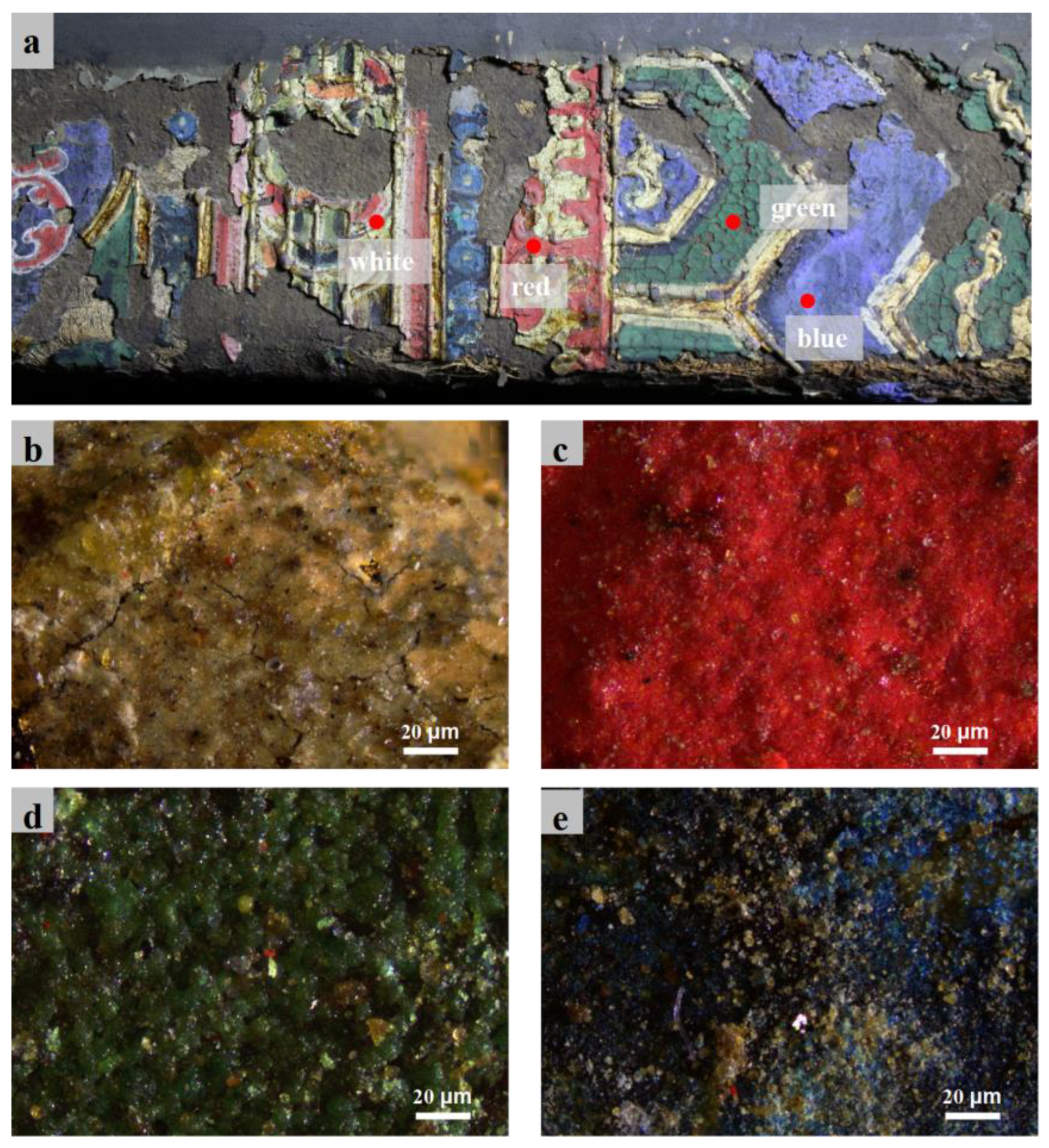
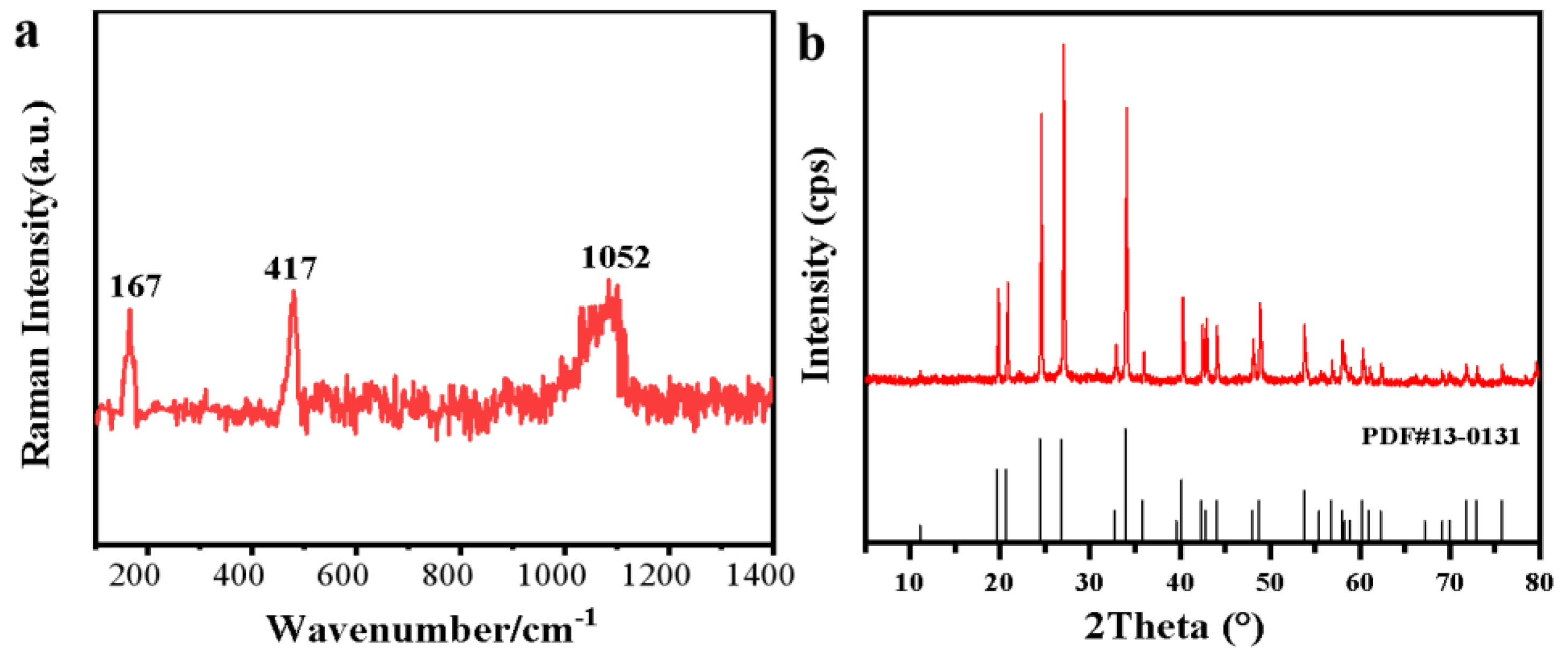
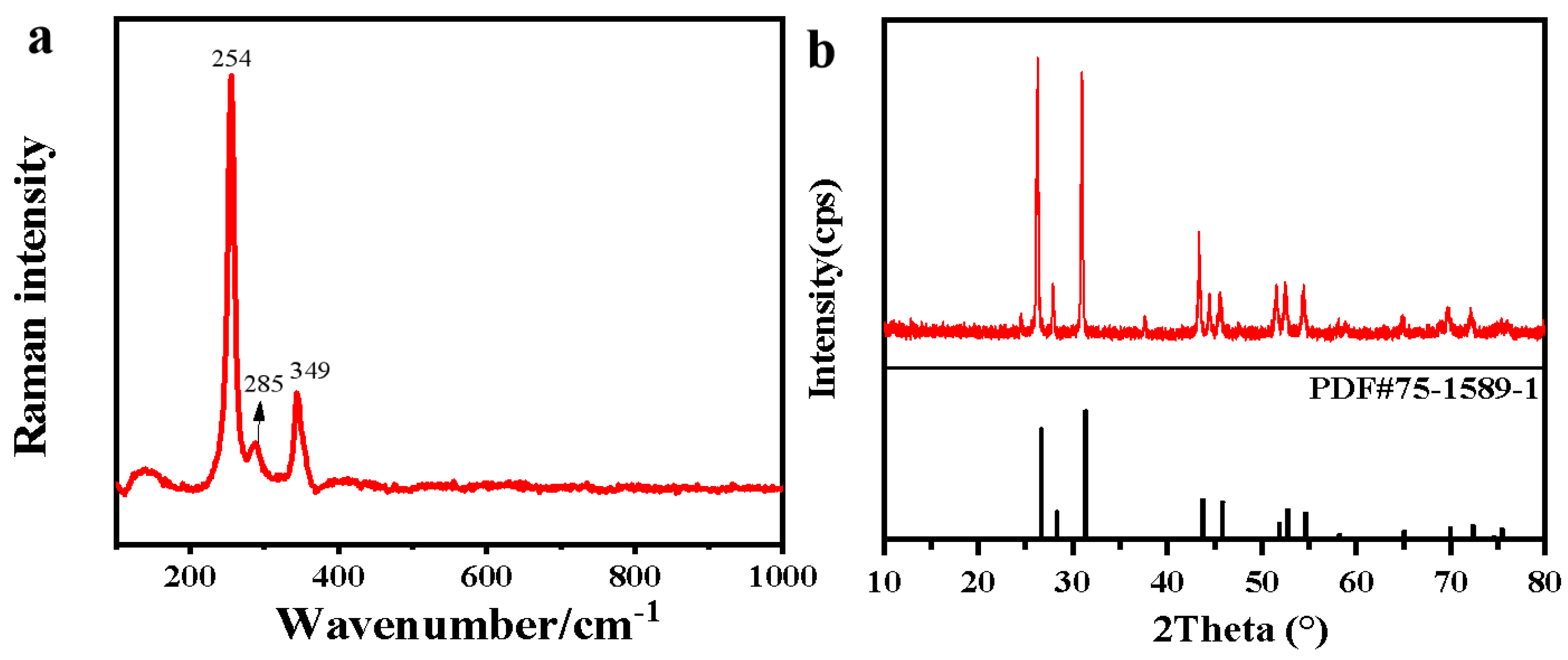

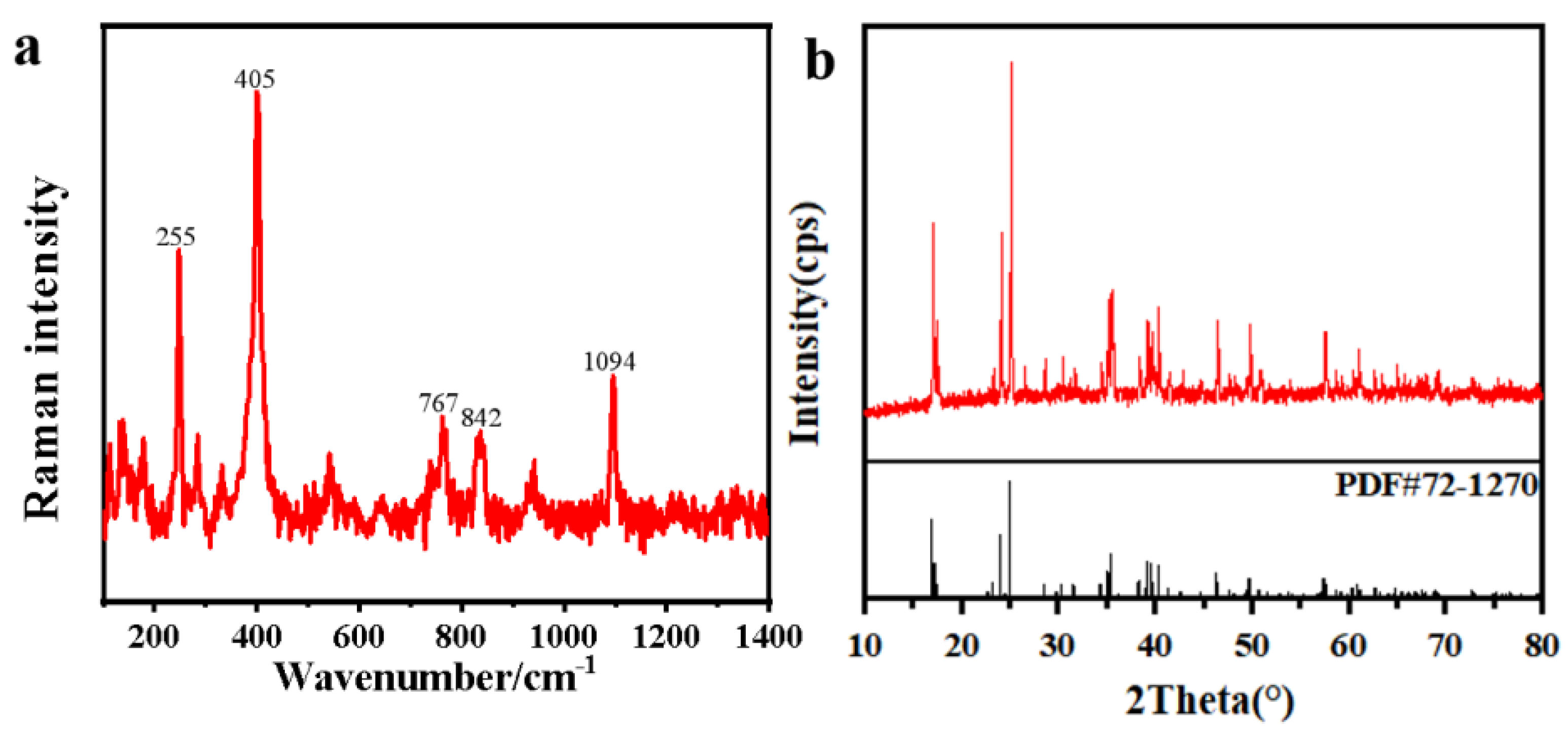
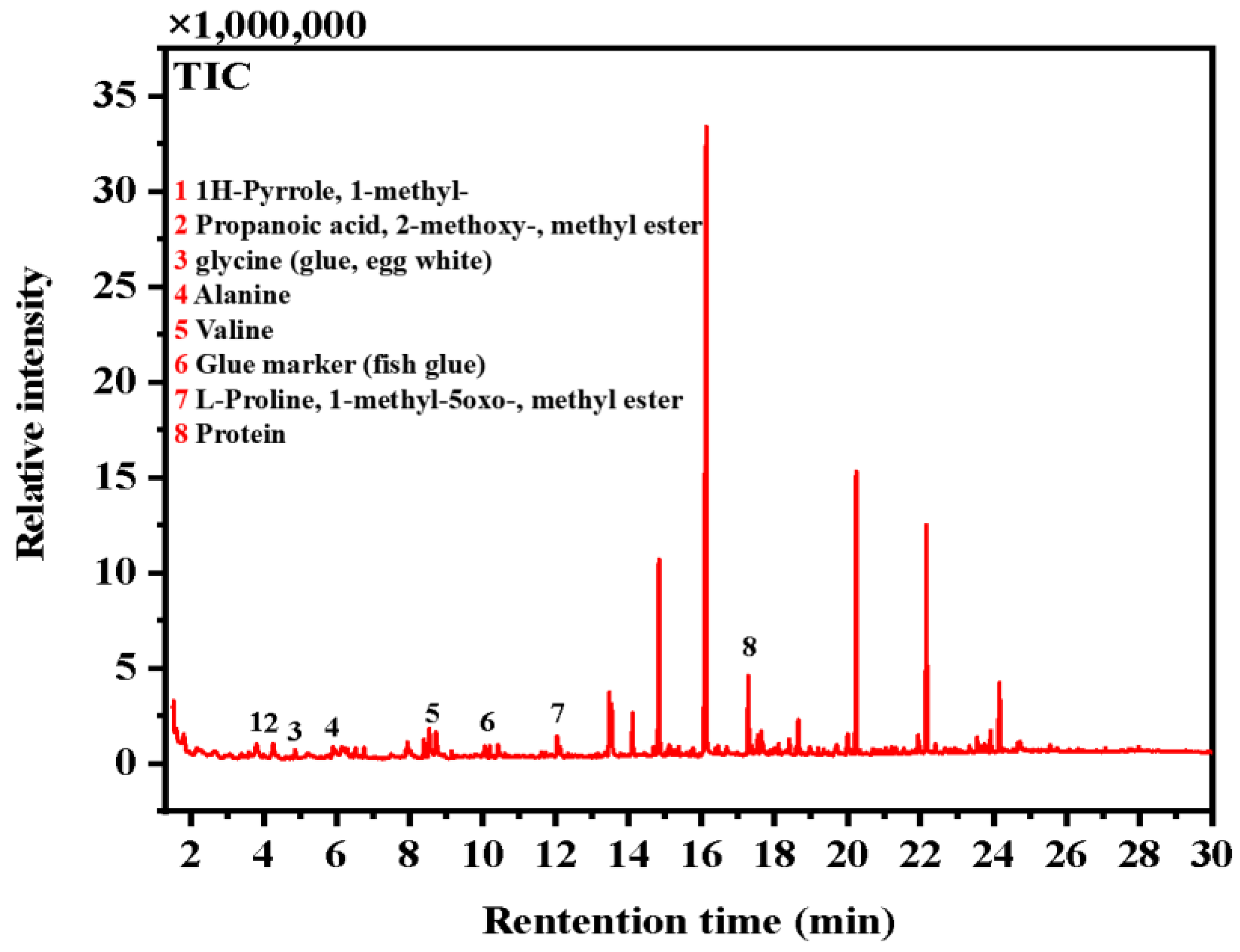
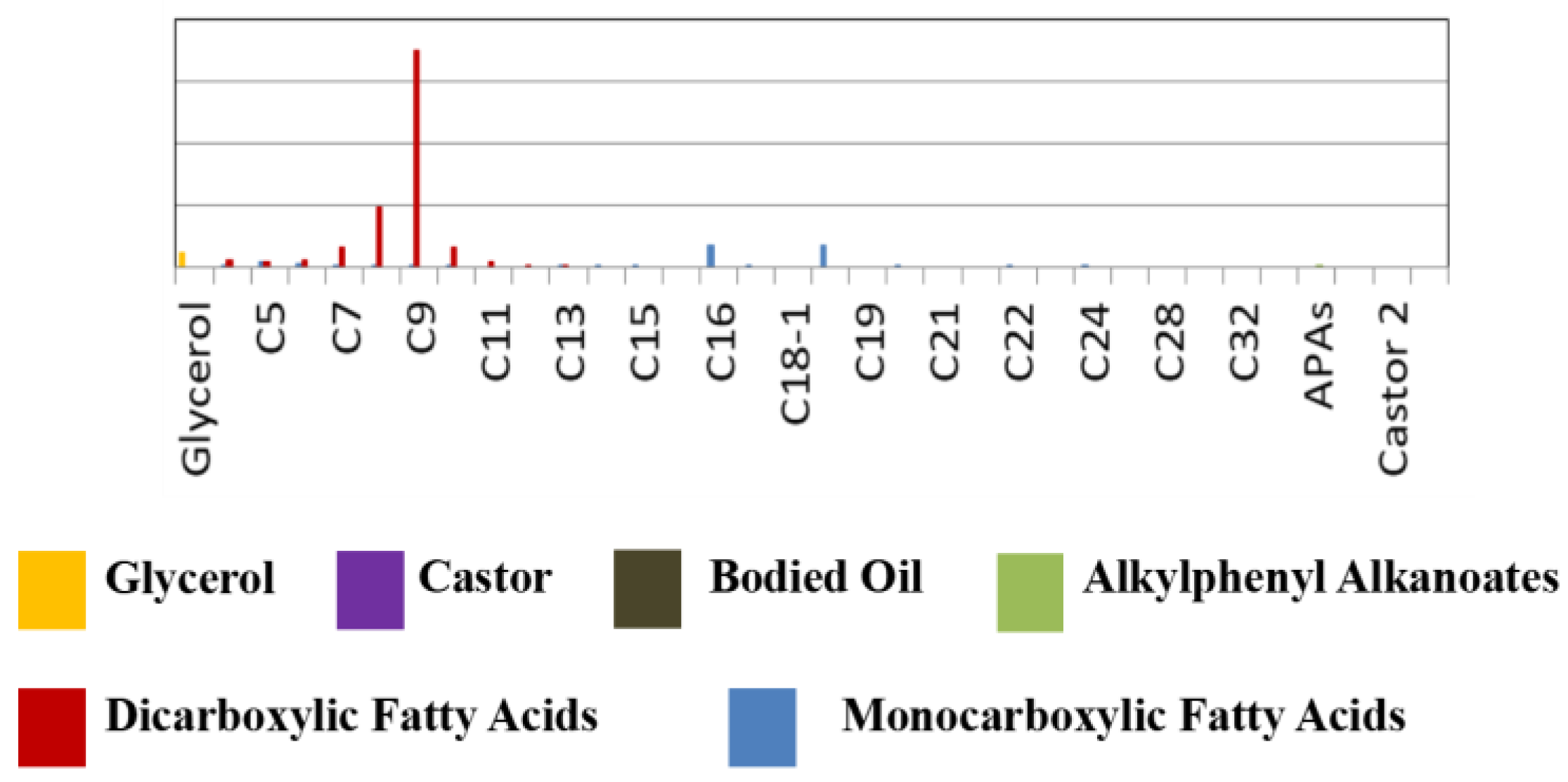
| Sample | Color | Elements | SEM (×500) |
|---|---|---|---|
| 1 | White | Pb (60.9%), Ca (16.2%), Fe (8.3%), Si (5.0%), K (4.3%) | 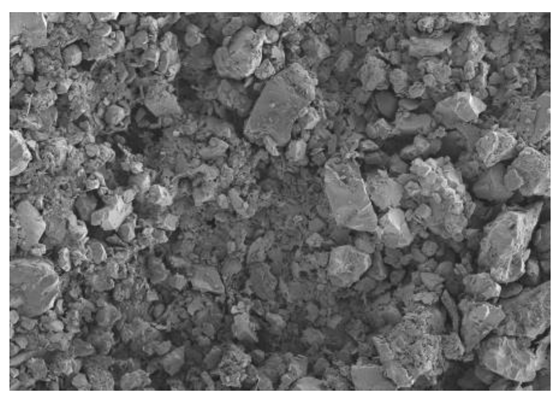 |
| 2 | Red | Pb (53.5%), Hg (28.2%), Ca (5.0%), K (3.6%), Si (2.8%) | 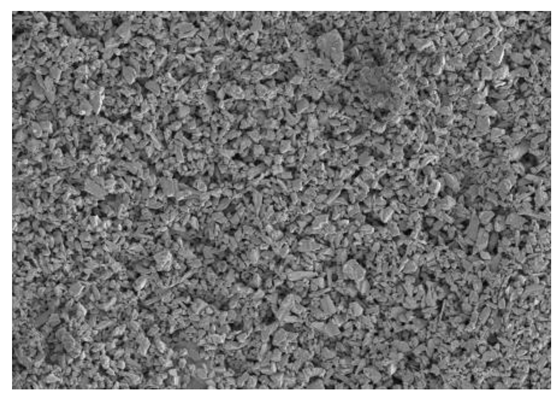 |
| 3 | Green | Cu (82.5%), Si (7.1%), Ca (3.8%), Pb (1.97%), Fe (1.87%) | 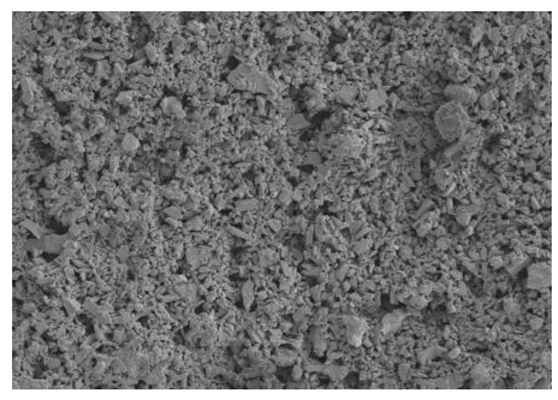 |
| 4 | Blue | Cu (81.8%), Si (7.4%), Ca (3.7%), Pb (1.87%), K (1.8%) | 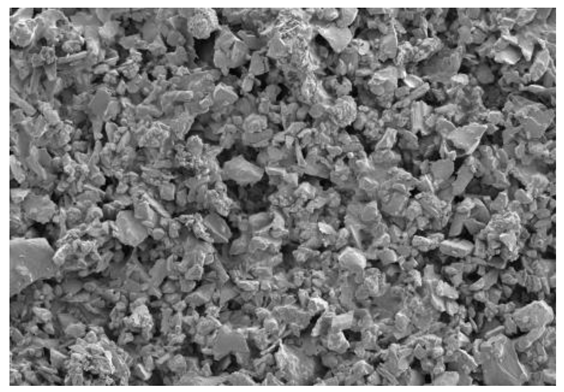 |
Disclaimer/Publisher’s Note: The statements, opinions and data contained in all publications are solely those of the individual author(s) and contributor(s) and not of MDPI and/or the editor(s). MDPI and/or the editor(s) disclaim responsibility for any injury to people or property resulting from any ideas, methods, instructions or products referred to in the content. |
© 2024 by the authors. Licensee MDPI, Basel, Switzerland. This article is an open access article distributed under the terms and conditions of the Creative Commons Attribution (CC BY) license (https://creativecommons.org/licenses/by/4.0/).
Share and Cite
Li, J.; Zhao, R. A Multi-Method Analysis of a Color Painting on Ancient Architecture from Anyuan Temple in Chengde, China. Coatings 2024, 14, 559. https://doi.org/10.3390/coatings14050559
Li J, Zhao R. A Multi-Method Analysis of a Color Painting on Ancient Architecture from Anyuan Temple in Chengde, China. Coatings. 2024; 14(5):559. https://doi.org/10.3390/coatings14050559
Chicago/Turabian StyleLi, Juan, and Rong Zhao. 2024. "A Multi-Method Analysis of a Color Painting on Ancient Architecture from Anyuan Temple in Chengde, China" Coatings 14, no. 5: 559. https://doi.org/10.3390/coatings14050559




